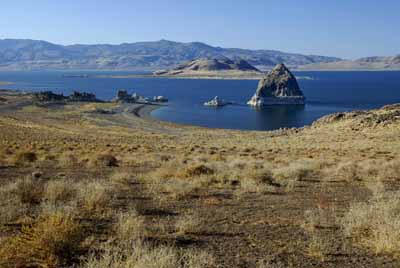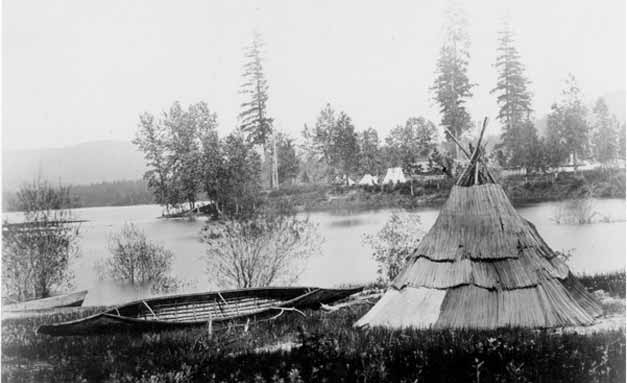
Plateau or Great Basin
This land is called the Great Basin because no water that falls as rain or snow or comes up from the ground in springs ever makes it to any ocean.
I. Who were the Plateau peoples? Lived in the Great Basin area and on north-western Plateau; the lands are in what are now the American states of Washington, Oregon, California, Nevada, Idaho, Montana and also in the province of British Columbia, Canada. Bannock, Coeur d'Alene, Cowlitz, Flathead, Fort Klamath, Kalapuya, Klikitat, Modoc, Nespelem, Nez Pierce, Paiute, Salish, Shoshoni, Spokane, Umatilla, Ute, Walla Walla, Washo, Wishram, Yakima.
 |
| The lands of the Plateau are harsh and dry, but the lakes made life possible. This is a picture of Pyramid Lake, Nevada. |
A. Environment very harsh, soil poor in most places, but also lush environs around place of water.
1. Resulted in sparse peopling. Oldest known occupation 9,000 B.P.
a. Coprolites, textiles, mummy (willow leaf), packrat nests at Wendover etc.
b. Waves of successive occupation.
i. mixed populations in later times.
c. Mostly Shoshone spoken in Southern and Eastern areas, believed to have emigrated from south-central plains in “Shoshone wedge.”
d. Simple burials with few artifacts interred.
e. Emphasis not on endless accumulation of personal possessions.
2. For food they relied on tule (cattail) root and pollen, gathered annual seeds, roasted pine nuts, roasted agave and yucca hearts (stems), made pancakes of wokas(water lily) seed, rabbits and waterfowl.
3. Traded obsidian and mountain goat horn with peoples of the Northwest Coast and obsidian with Northern Californians.
 |
| Sinyakwatin in 1860, shows an American camp on the south side of Pend Oreille River, Idaho, with a Kalispel canoe and tule-mat tepee in the foreground |
B. Architecture mostly wikiup of woven reed mats over wooden-pole frame.
1. Early occupations cave centered.
2. Replaced by teepees and canvas tents in historic period.
C. Personal adornment varied by season.
1. Men wore breechcloth and leggings when traveling away from home.
2. Women favored a two piece dress (skirt and blouse), and tall boot moccasins in cold season.
3. Hair centrally parted and braided.
4. Carried bandolier bags or parfleches.
a. Bags woven on loom of dyed corn husk, designs are different on both faces. Modern times are wool yarn.
5. Spectacular bead work, Wishram wedding veil.
6. Hide tanning was well developed here, and designs were frequently painted on in red, white, blue, yellow, black pigments.
D. Horse finery in historic times.
1. Designs frequently rely on bordered color fields and geometric designs.
F. The tule (cattail). - the most critical resource.
1. Rope and cordage of tule.
2. Woven mats for sitting, sleeping, house siding in winter, wrapping the dead.
3. Baskets made in amazing variety. Twined and coiled both typical.
a. Still-water transport - balsas and rafts.
b. Food gathering, prep, serving, and, storage. Most used here.
c. Traps, weirs usually made by men.
d. Pitched water bottles, with narrow necks. Usually, made of willow.
e. Imbrication with colored barks and “coffin” shapes from Frazier River area.
f. Cradle boards.
g. Sold to white Americans after 1890 in large numbers.
i. Among the artisans was Dat-so-la-lee, whose genius was unrivaled. In later years she sold baskets by other women as her own to increase the prices for all, thus forming the first branded Indian merchandise, that was produced by a cooperative of women.
4. Weather gear - gaiters, shoes, capes, leggings.
5. Clothing
a. Cloaks and footgear for all.
b. Leggings, for men.
c. Skirts of shredded tules for women.
d. Hats for women.
6. Duck decoys.
 |
|
| Tule duck decoy covered with the skin of a duck to aid in camouflage. |
Duck decoys ca. 400 BC–AD 100 Lovelock Cave, Humboldt County, Nevada Tule rush, feathers, cordage, paint 31 x 12 cm |
G. Other fibers
1. Mountain goat hair traded to the peoples of the Northwest Coast.
2. Rabbit skin and twine woven
a. Blankets for bedding
b. Robes and leggings and shoe liners worn for warmth in winter
3. Twine of milkweed fiber.
4. shredded sagebrush bark for summer skirts.
G. Minerals
1. Obsidian of unusual purity for making blades and knives
a. traded with Northern and Northeastern Californians and Northwest Coast peoples.
2. Red ochre of a high quality
a. traded with peoples all around.
b. highly desired in the Northwest Coast for red paint.
3. Copper in pure nuggets of varying sizes up to several tons.
a. highly desired by Northwest Coast peoples for accenting objects.
b. highly desired in the Arctic for women's knives.
H. Horn and antler
1. Harvested mountain goat horn for trade with folks to the west for men's spoons.
2. Traded elk antler to the people of the West Coast for purses for their money.